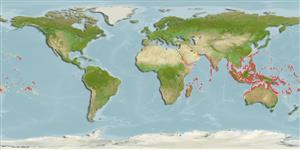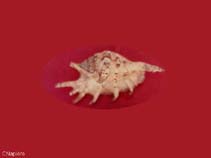Lambis lambis (Linnaeus, 1758)
Common spider conch| Native range | All suitable habitat | Point map | Year 2050 |

|
| This map was computer-generated and has not yet been reviewed. |
| Lambis lambis AquaMaps Data sources: GBIF OBIS |
Classification / Names Common names | Synonyms | CoL | ITIS | WoRMS
Gastropoda | Littorinimorpha | Strombidae
Environment: milieu / climate zone / depth range / distribution range Ecology
Benthic; depth range 0 - 24 m (Ref. 349). Tropical; 29°N - 29°S, 33°E - 126°W
Distribution Countries | FAO areas | Ecosystems | Occurrences | Introductions
Indo-Pacific: from East Africa, India, Sri Lanka, Andaman and Nicobar Islands, east to southeast Asia and Australia, as far east to French Polynesia and north to Japan. Subtropical and tropical.
Length at first maturity / Size / Weight / Age
Maturity: Lm ? range ? - ? cm Max length : 29.0 cm SHL male/unsexed; (Ref. 349); common length : 18.0 cm SHL male/unsexed; (Ref. 349)
Short description Morphology
Sexual dimorphism pronounced. Shell of the males usually smaller and with shorter digitations on the outer lip.
Often collected for food by coastal populations, and the shell used in shellcraft (Ref. 349). Maximum depth from Ref. 106336. Occurs at the low tide mark (Ref. 349), intertidal and found on subtidal reef and seagrass (Ref. 98588). It is also found on sand, weeds near corals (Ref. 799), muddy areas (Ref. 97553), reef-flats, coral rubble bottoms or mangrove areas (Ref. 128042). Shallowly burrows in sand or gravel. Grazes on animal matter in the mud. Also predominantly feeds on sand grains, polychaetes, bivalves and small crustaceans (Ref. 97553).
Life cycle and mating behavior Maturity | Reproduction | Spawning | Eggs | Fecundity | Larvae
Members of the order Neotaenioglossa are mostly gonochoric and broadcast spawners. Life cycle: Embryos develop into planktonic trocophore larvae and later into juvenile veligers before becoming fully grown adults.
Main reference
References | Coordinator | Collaborators
Poutiers, J.M. 1998. (Ref. 349)
IUCN Red List Status (Ref. 130435)
CITES status (Ref. 108899)
Not Evaluated
CMS (Ref. 116361)
Not Evaluated
Threat to humans
Harmless
Human uses
Fisheries: commercial
| FishSource | Sea Around Us
Tools
More information
Internet sources
BHL | BOLD Systems | CISTI | DiscoverLife | FAO(Publication : search) | Fishipedia | GenBank (genome, nucleotide) | GloBI | Gomexsi | Google Books | Google Scholar | Google | PubMed | Tree of Life | Wikipedia (Go, Search) | Zoological Record
Estimates based on models
Preferred temperature
(Ref. 115969): 25.2 - 29.3, mean 28.5 (based on 3353 cells).
Prior r = 0.57, 95% CL = 0.37 - 0.85, Based on 1 data-limited stock assessment.
Price category
(Ref. 80766):
Unknown.
Nutrients: Calcium = 126 [75, 177] mg/100g; Iron = 4.79 [1.67, 7.92] mg/100g; Protein = 15.9 [14.8, 16.9] %; Omega3 = 0.331 [0.263, 0.400] g/100g; Selenium = 57.8 [48.5, 67.2] μg/100g; VitaminA = 0 μg/100g; Zinc = 1.97 [0.92, 3.02] mg/100g (wet weight).



